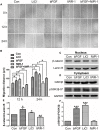Feedback Activation of Basic Fibroblast Growth Factor Signaling via the Wnt/β-Catenin Pathway in Skin Fibroblasts
- PMID: 28217097
- PMCID: PMC5289949
- DOI: 10.3389/fphar.2017.00032
Feedback Activation of Basic Fibroblast Growth Factor Signaling via the Wnt/β-Catenin Pathway in Skin Fibroblasts
Abstract
Skin wound healing is a complex process requiring the coordinated behavior of many cell types, especially in the proliferation and migration of fibroblasts. Basic fibroblast growth factor (bFGF) is a member of the FGF family that promotes fibroblast migration, but the underlying molecular mechanism remains elusive. The present RNA sequencing study showed that the expression levels of several canonical Wnt pathway genes, including Wnt2b, Wnt3, Wnt11, T-cell factor 7 (TCF7), and Frizzled 8 (FZD8) were modified by bFGF stimulation in fibroblasts. Enzyme-linked immunosorbent assay (ELISA) analysis also showed that Wnt pathway was activated under bFGF treatment. Furthermore, treatment of fibroblasts with lithium chloride or IWR-1, an inducer and inhibitor of the Wnt signaling pathway, respectively, promoted and inhibited cell migration. Also, levels of cytosolic glycogen synthase kinase 3 beta phosphorylated at serine9 (pGSK3β Ser9) and nuclear β-catenin were increased upon exposure to bFGF. Molecular and biochemical assays indicated that phosphoinositide 3-kinase (PI3K) signaling activated the GSK3β/β-catenin/Wnt signaling pathway via activation of c-Jun N-terminal kinase (JNK), suggesting that PI3K and JNK act at the upstream of β-catenin. In contrast, knock-down of β-catenin delayed fibroblast cell migration even under bFGF stimulation. RNA sequencing analysis of β-catenin knock-down fibroblasts demonstrated that β-catenin positively regulated the transcription of bFGF and FGF21. Moreover, FGF21 treatment activated AKT and JNK, and accelerated fibroblast migration to a similar extent as bFGF does. In addition, ELISA analysis demonstrated that both of bFGF and FGF21 were auto secretion factor and be regulated by Wnt pathway stimulators. Taken together, our analyses define a feedback regulatory loop between bFGF (FGF21) and Wnt signaling acting through β-catenin in skin fibroblasts.
Keywords: GSK3β; Wnt signaling pathway; bFGF; cell migration; transcriptome; β-catenin.
Figures








Similar articles
-
The activation of the NF-κB-JNK pathway is independent of the PI3K-Rac1-JNK pathway involved in the bFGF-regulated human fibroblast cell migration.J Dermatol Sci. 2016 Apr;82(1):28-37. doi: 10.1016/j.jdermsci.2016.01.003. Epub 2016 Jan 7. J Dermatol Sci. 2016. PMID: 26829882
-
Hedgehog signaling contributes to basic fibroblast growth factor-regulated fibroblast migration.Exp Cell Res. 2017 Jun 15;355(2):83-94. doi: 10.1016/j.yexcr.2017.03.054. Epub 2017 Mar 28. Exp Cell Res. 2017. PMID: 28363830
-
Lucidone Promotes the Cutaneous Wound Healing Process via Activation of the PI3K/AKT, Wnt/β-catenin and NF-κB Signaling Pathways.Biochim Biophys Acta Mol Cell Res. 2017 Jan;1864(1):151-168. doi: 10.1016/j.bbamcr.2016.10.021. Epub 2016 Nov 2. Biochim Biophys Acta Mol Cell Res. 2017. PMID: 27816443
-
Vasculogenesis and angiogenesis initiation under normoxic conditions through Wnt/β-catenin pathway in gliomas.Rev Neurosci. 2018 Jan 26;29(1):71-91. doi: 10.1515/revneuro-2017-0032. Rev Neurosci. 2018. PMID: 28822229 Review.
-
Crosstalk Between Peroxisome Proliferator-Activated Receptor Gamma and the Canonical WNT/β-Catenin Pathway in Chronic Inflammation and Oxidative Stress During Carcinogenesis.Front Immunol. 2018 Apr 13;9:745. doi: 10.3389/fimmu.2018.00745. eCollection 2018. Front Immunol. 2018. PMID: 29706964 Free PMC article. Review.
Cited by
-
Anti-fibrotic effects of pharmacologic FGF-2: a review of recent literature.J Mol Med (Berl). 2022 Jun;100(6):847-860. doi: 10.1007/s00109-022-02194-3. Epub 2022 Apr 28. J Mol Med (Berl). 2022. PMID: 35484303 Review.
-
Organoid-Guided Precision Medicine: From Bench to Bedside.MedComm (2020). 2025 May 1;6(5):e70195. doi: 10.1002/mco2.70195. eCollection 2025 May. MedComm (2020). 2025. PMID: 40321594 Free PMC article. Review.
-
Promotion of excisional wound repair by a menstrual blood-derived stem cell-seeded decellularized human amniotic membrane.Biomed Eng Lett. 2018 Sep 11;8(4):393-398. doi: 10.1007/s13534-018-0084-1. eCollection 2018 Nov. Biomed Eng Lett. 2018. PMID: 30603224 Free PMC article.
-
Roles of the fibroblast growth factor signal transduction system in tissue injury repair.Burns Trauma. 2022 Mar 23;10:tkac005. doi: 10.1093/burnst/tkac005. eCollection 2022. Burns Trauma. 2022. PMID: 35350443 Free PMC article. Review.
-
The Roles of WNT Signaling Pathways in Skin Development and Mechanical-Stretch-Induced Skin Regeneration.Biomolecules. 2023 Nov 24;13(12):1702. doi: 10.3390/biom13121702. Biomolecules. 2023. PMID: 38136575 Free PMC article. Review.
References
LinkOut - more resources
Full Text Sources
Other Literature Sources
Molecular Biology Databases
Research Materials
Miscellaneous

